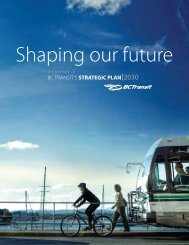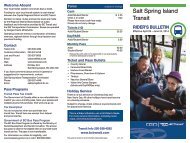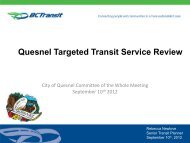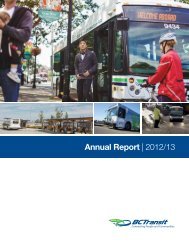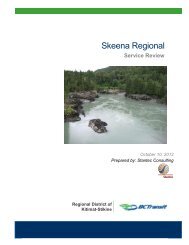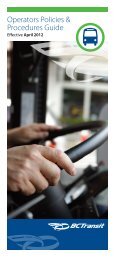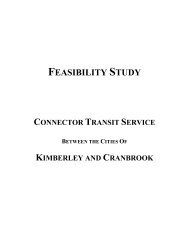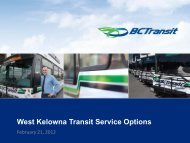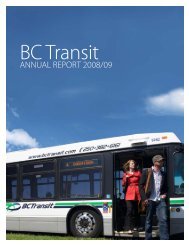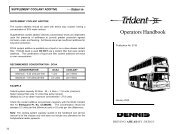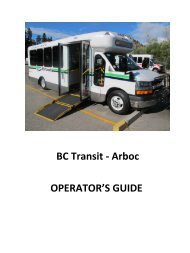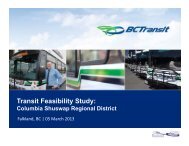Regional District of Nanaimo Transit Future Plan Terms ... - BC Transit
Regional District of Nanaimo Transit Future Plan Terms ... - BC Transit
Regional District of Nanaimo Transit Future Plan Terms ... - BC Transit
Create successful ePaper yourself
Turn your PDF publications into a flip-book with our unique Google optimized e-Paper software.
22.0 Scope <strong>of</strong> Work<strong>Transit</strong> <strong>Future</strong> <strong>Plan</strong> Study AreaThe <strong>Regional</strong> <strong>District</strong> <strong>of</strong> <strong>Nanaimo</strong> <strong>Transit</strong> <strong>Future</strong> <strong>Plan</strong> study area includes all municipalities andpopulated areas within the RDN, even those areas currently not served by transit. The plan will includeboth the conventional and custom transit systems.Project Components1. Stakeholder and Community EngagementA. Community Engagement Approacha. Inform – Keep our stakeholders and the community up to date on project progressand how feedback can be providedb. Listen – An opportunity for our stakeholders and the community to provide feedbackon to what degree the current transit system meets the needs <strong>of</strong> the community andwhat role they see transit playing in their community moving forward.c. Report Back – At this stage we will be feeding back to the community and ourstakeholders the project vision and goals and the proposed <strong>Transit</strong> <strong>Future</strong> Networkthat were developed using background data and the feedback we heard earlier on inthe processB. The <strong>Transit</strong> <strong>Future</strong> engagement process will be integrated with any local government planssuch as the City <strong>of</strong> <strong>Nanaimo</strong>’s Transportation Master <strong>Plan</strong> engagement process whenappropriateC. Identify key stakeholders and the structure <strong>of</strong> project working groups for the <strong>Transit</strong> <strong>Future</strong><strong>Plan</strong> process. Outline key opportunities for review and feedback from each groupD. Identify key opportunities for feedback and review from the public at largeE. Discuss strategies for each public engagement opportunityF. Outline media and communications requirements including the use <strong>of</strong> web and print material2. Context – Review Local Government <strong>Plan</strong>s, Demographic Trends and the Existing <strong>Transit</strong>Business <strong>Plan</strong> and <strong>Transit</strong> SystemA. Review context information gathered as part <strong>of</strong> the City <strong>of</strong> <strong>Nanaimo</strong> Master Transportation<strong>Plan</strong> processB. Review <strong>of</strong> plans, policies and objectives related to transit, transportation, land use andgreenhouse gas emissions in the RDN. This includes, but is not limited to the <strong>Transit</strong>Business <strong>Plan</strong>, <strong>Regional</strong> Growth Strategy, Master Transportation <strong>Plan</strong>, Official Community<strong>Plan</strong> (OCP), Neighborhood <strong>Plan</strong>s and other community led plansC. Review available transit data and collect new data where requiredD. Review existing service performance, ridership stats, and efficiency measuresE. Review current travel movementsF. Identify current service gapsG. Document current contextual data including demographics, land use, and traffic patternsH. Inventory existing transit infrastructure and customer informationI. Identify key future travel movements and identify temporal patterns for these movementsJ. Forecast service levels required to meet ridership, mode split, and greenhouse gasreduction targetsK. Review projected demographic and land use trends



